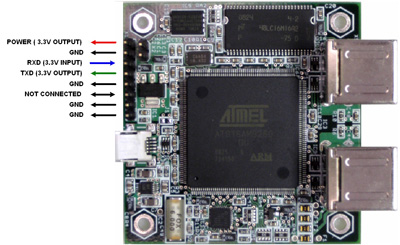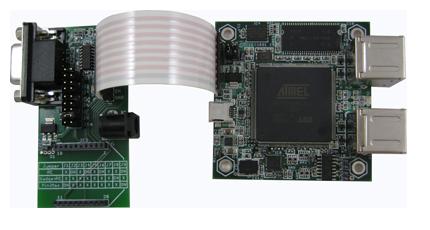GadgetPC Support & Frequently Asked Questions
[1] What flavor of Linux does GadgetPC run ?
[2] Are the USB host ports protected ?
[3] Does GadgetPC support any USB device ?
[4] How do I see console of GadgetPC ? How can I connect GadgetPC to the serial port of my PC ?
[5] Can I use any USB Flash Drive with GadgetPC ?
[6] My USB devices do not work. What is the problem ?
[7] How much power does GadgetPC really consume ?
[8] Can I write C programs that are just embedded without requiring Linux?
[9] Is there any way to support scripting languages like Python or Perl?
[10] What is the advantage of ARM9 Linux versus Debian?
[11] Is there any other documentation that is provided that is not on the web site? What other resources (books, internet sites, etc.) would you recommend ?
[12] Can I put Linux inside on-board DataFlash and avoid external USB drive ?
[1] What flavor of Linux does GadgetPC run ?
GadgetPC supports the full Linux kernel that is compiled using GCC Cross Compiler for ARM9. GadgetPC also supports Debian 5.0 or higher. Please see GadgetPC documents on how to use GadgetPC with Debian.
[2] Are the USB host ports protected ?
On versions 1.01 and 1.02 of GadgetPC boards, the USB host ports are protected using resettable fuses. On version 1.03 and higher boards, USB ports are also electronically protected with a circuit that measures USB port current and shuts down the port if a fault condition is detected.
[3] Does GadgetPC support any USB device ?
GadgetPC hardware supports any Low Speed (1.2Mbit/sec ) or Full Speed ( 12Mbit/sec ) USB device. High Speed ( 480 Mbit/sec ) USB devices are supported only Low Speed or Full speed modes.
GadgetPC Linux supports only those USB devices for which there is a software driver. BiPOM maintains an ever growing list of suitable Linux drivers to support various USB devices. It is recommended that you use USB devices that are supported by BiPOM.
Please see Supported Hardware document for the latest list of supported USB devices.
[4] How do I see console of GadgetPC ? How can I connect GadgetPC to the serial port of my PC ?
The RS232 serial port on GadgetPC is TTL level. You can use a TTL to RS232 level converter to connect GadgetPC to your computer's serial port. We offer such a TTL to RS232 converter with part #: BRD-RS232-TTL-1. By default, console output of GadgetPC goes to the serial port.
UART pinout of GadgetPC
BRD-RS232-TTL-1 connected to GadgetPC
[5] Can I use any USB Flash Drive with GadgetPC ?
Most USB Flash Drives work well but some are not recognized by U-Boot ( the boot loader for GadgetPC ). Lexar FireFly USB drives work well. Please check the list of supported hardware under Documents section of GadgetPC for a full list of tested hardware.
[6] My USB devices do not work. What is the problem ?
Most of the time, this is caused by the fact that the USB device has not been pushed all the way in. As simple as this sounds, we have seen this happen. USB port requires the device to be inserted all the way in to make proper contact. Also, check to see if your USB device is in the list of Supported Hardware to see if your USB device is supported.
[7] How much power does GadgetPC really consume ?
In its simplest configuration ( no USB devices, no USB Flash drive, Linux booting from on-board DataFlash ), GadgetPC consumes about 110mA at 5 Volts.
With DataFlash, the current consumption may increase to anywhere from 140 to 180 mA at 5 Volts depending on USB Flash drive type and operation ( read, write or idle ).
Current consumption of GadgetPC with USB Flash drive and D-Link DUB-E100 Ethernet card is around 500mA at 5 Volts.Please see the document: GadgetPC Power Consumption Results for detailed results.
[8] Can I write C programs that are just embedded without requiring Linux?
Yes, you can. We provide such examples with ARM development system ( C:\bipom\devtools\GCC\AT91SAM9\Examples\Linux )
[9] Is there any way to support scripting languages like Python or Perl?
Yes, these should work since Linux supports them but we did not try.
[10] What is the advantage of ARM9 Linux versus Debian?
ARM9 Linux is simpler. Debian is more powerful. Please see the document Linux Options for ARM9 for more details.
[11] Is there any other documentation that is provided that is not on the web site? What other resources (books, internet sites, etc.) would you recommend ?
The board runs a standard Linux like on a PC. All standard knowledge from Linux world is applicable.
[12] Can I put Linux inside on-board DataFlash and avoid external USB drive ?
This is possible. You can move all your files to gpcfs.gz ( RAMDISK).Note, gpcfs.gz is a compressed disk image.You have to uncompress it and mount under Linux native machine.Then you can copy / remove all the necessary files.Then you can boot Linux kernel/gpcfs.gz from DataFlash.
U-boot commands to copy Linux RootFS/RAMDISK from USB to DataFlash:
usb start; fatload usb 0:1 0x20410000 gpcfs.gz; cp.b 0x20410000 0xD0430000 0x400000
U-boot commands to copy Linux kernel from USB to DataFlash:
usb start; fatload usb 0:1 0x21000000 uimage; cp.b 0x21000000 0xD0030000 0x200000
U-Boot commands to boot Linux/RAMDISK from DataFlash:
setenv bootcmd 'cp.b 0xD0030000 0x21000000 0x400000; cp.b 0xD0430000 0x20410000 0x400000; bootm 0x21000000'

